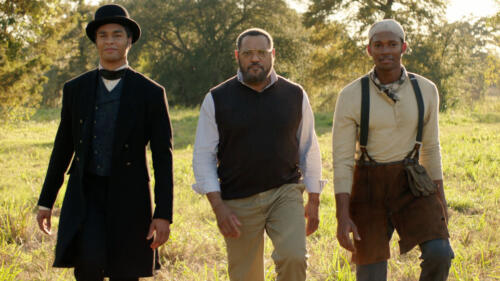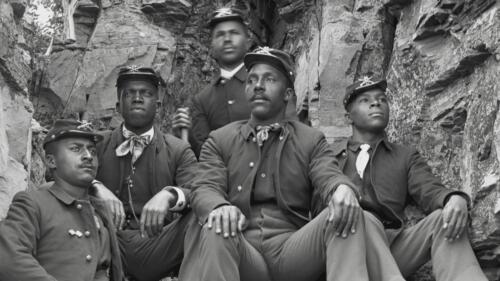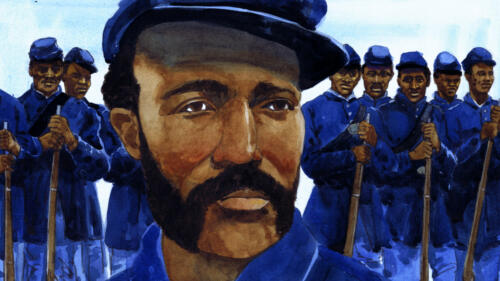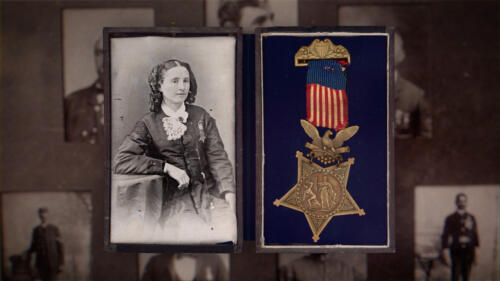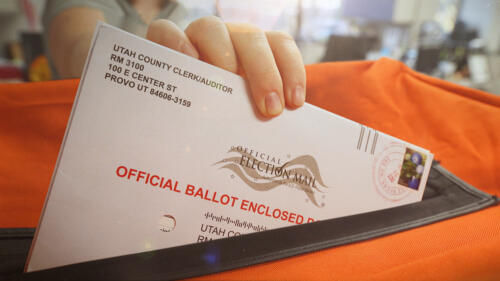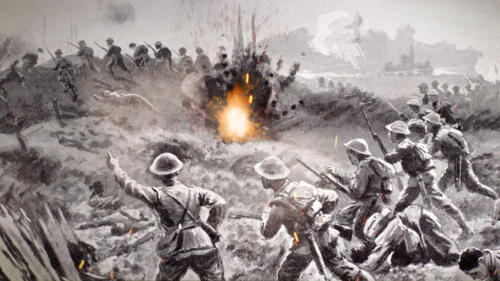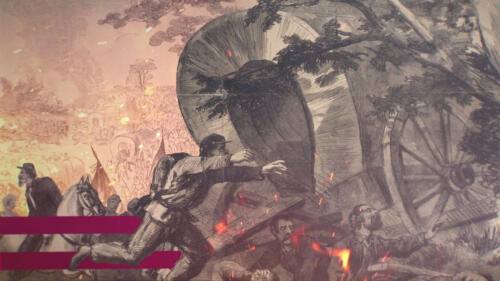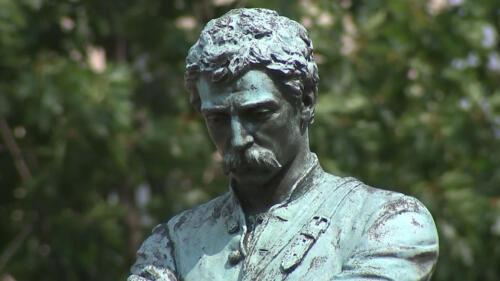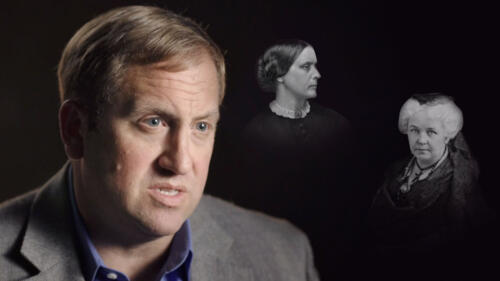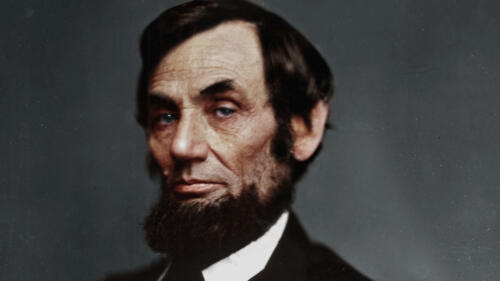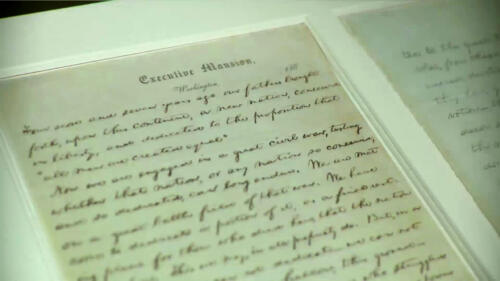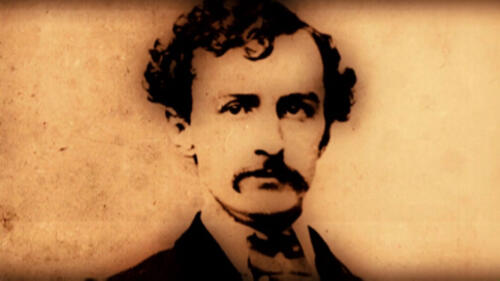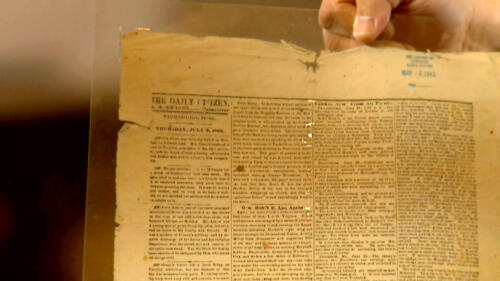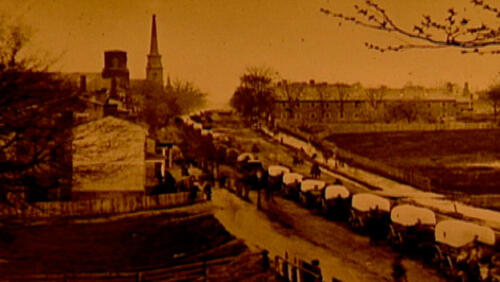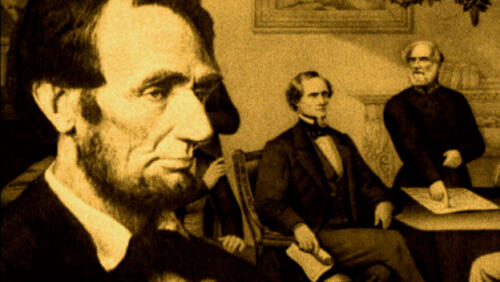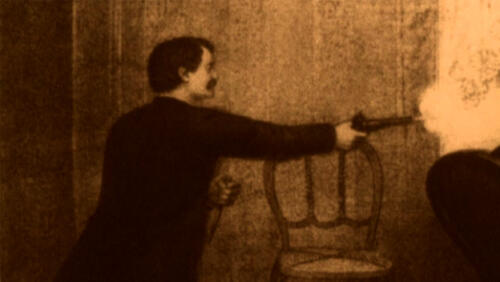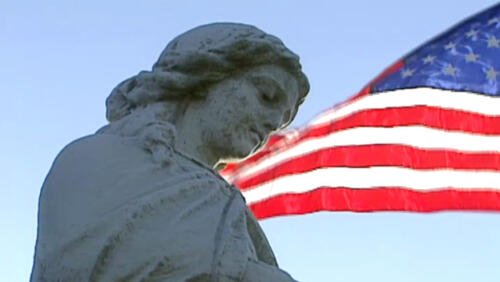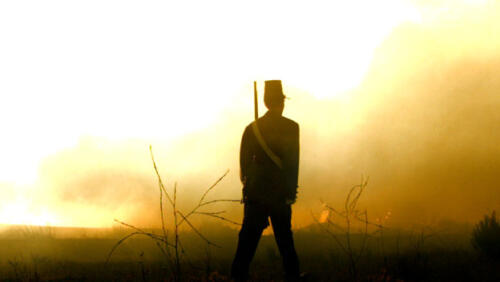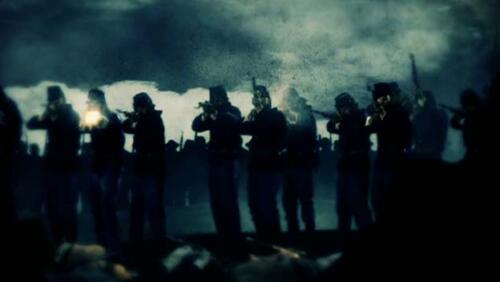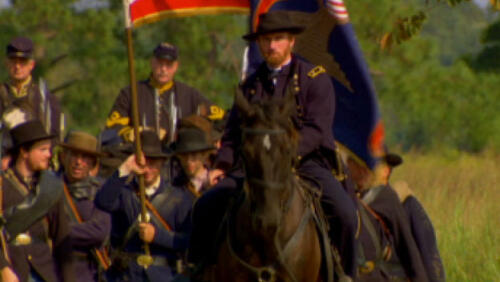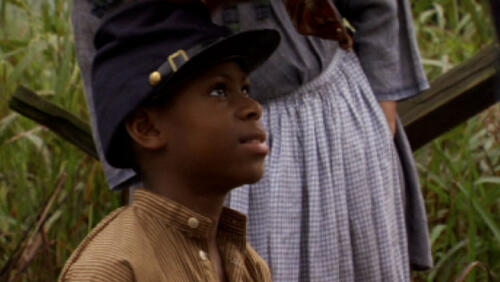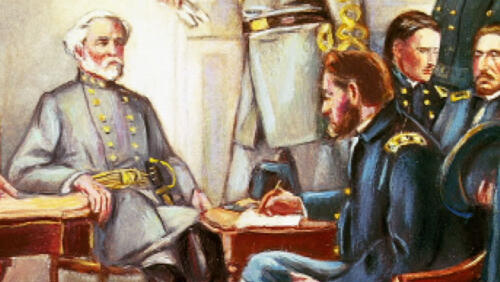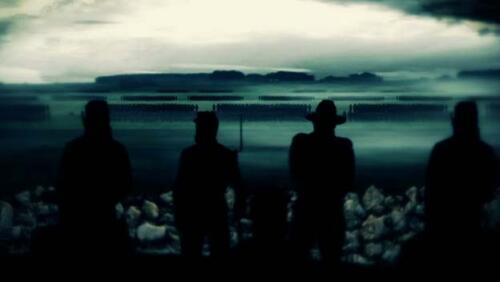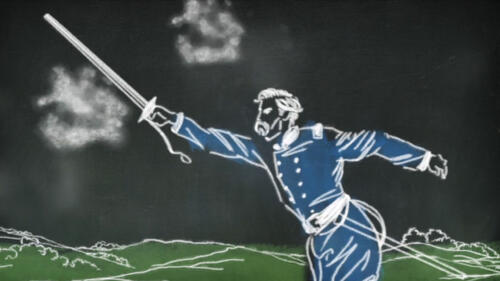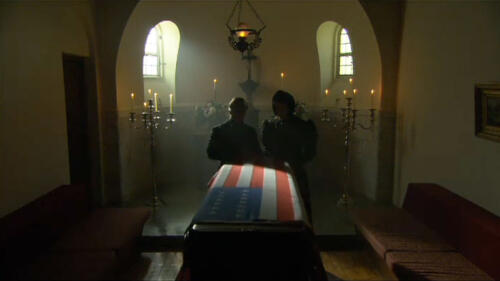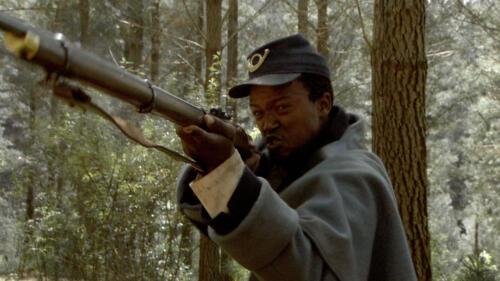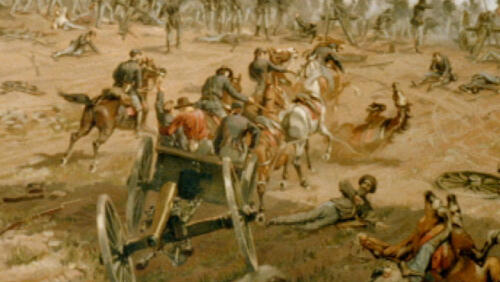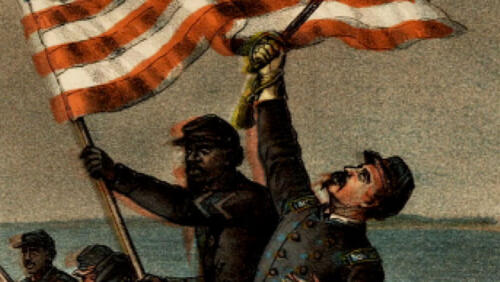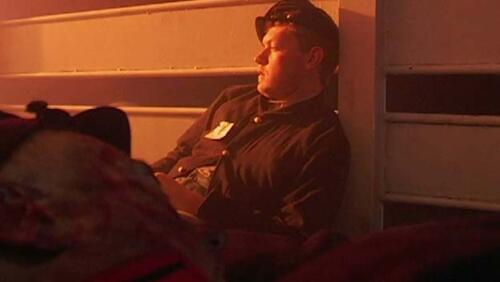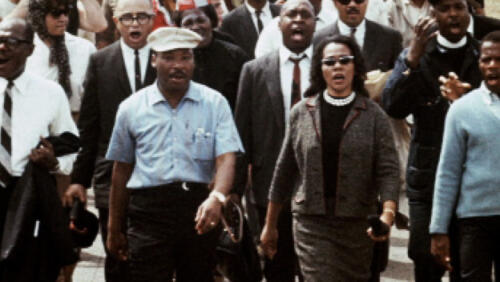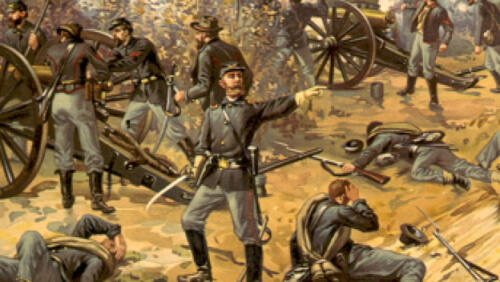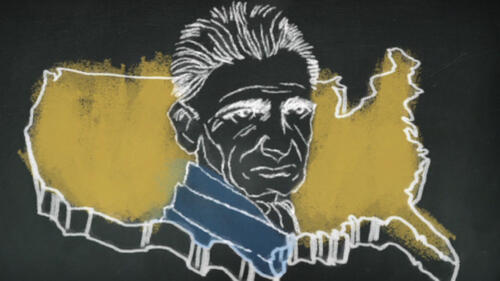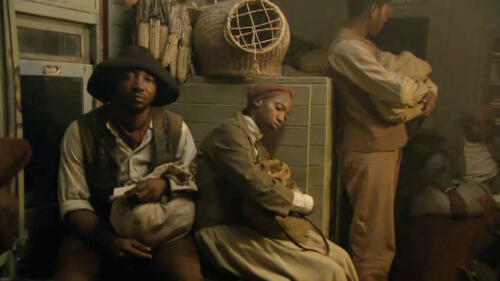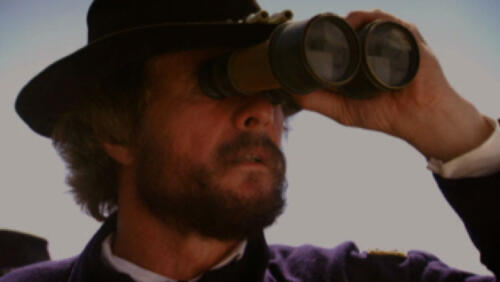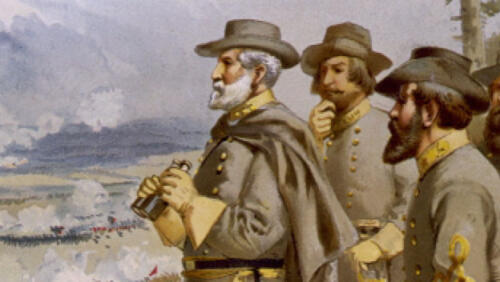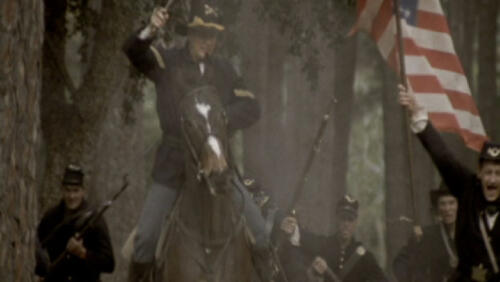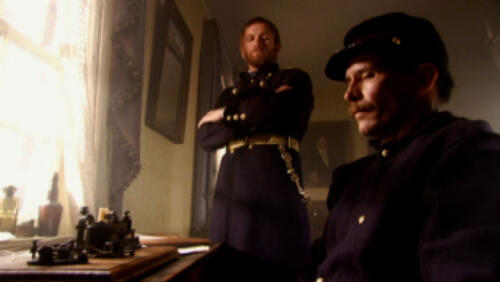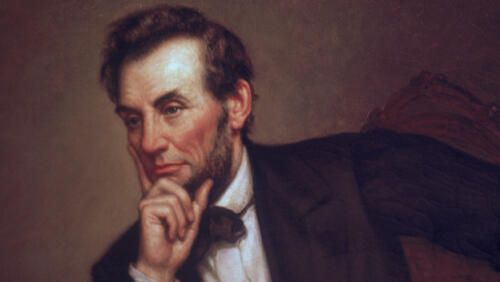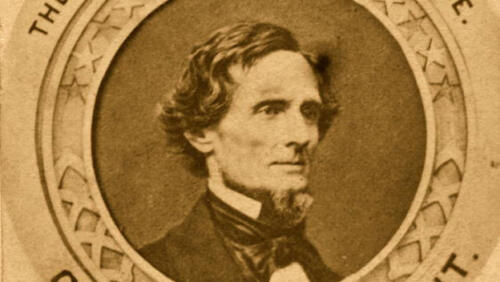Civil War
The Civil War was America's bloodiest and most divisive conflict, pitting the Union Army against the Confederate States of America. The war resulted in the deaths of more than 620,000 people, with millions more injured and the South left in ruins.
Featured Overview
Historians and experts look at the role of slavery in the Civil War and its effect on the U.S. from Reconstruction through the present day.
2:58m watch

Getty Images
Featured Overview
Historians and experts look at the role of slavery in the Civil War and its effect on the U.S. from Reconstruction through the present day.
2:58m watch
Start Here

The Civil War was a conflict many years in the making.

These battles were among the most pivotal in America's bloodiest conflict.

Images of the bloodiest battle in U.S. history shocked the public and revealed the war’s gruesome reality.

Abraham Lincoln's 1863 Gettysburg Address contains fewer than 275 words. How did such a short speech carry such a long-lasting impact?
Emancipation Proclamation
Lincoln's Emancipation Proclamation
Using a revolutionary new form of communication, President Abraham Lincoln issues the Emancipation Proclamation, which he believes will give the Union both a moral and strategic advantage, in this scene from "The March to War."
2:06 watch

3 Key Civil War Battles
Explore All Related Topics
The incredible story of the Nations' first all-Black peacetime regiments who fought to expand America's presence in the West, protect the National Parks and defend the U.S. on foreign soil.
7:57m watch
Grant surrounds and sieges Vicksburg, leading to a crucial victory for the Union.
10:34m watch

The department, established in 1867, faced opposition from congressmen who associated it with education for the formerly enslaved.

Abraham Lincoln's 1863 Gettysburg Address contains fewer than 275 words. How did such a short speech carry such a long-lasting impact?

A Civil War soldier's load typically weighed 30 to 40 pounds. This is what he wore—and carried.

Lawmakers drafted Section 3 of the 14th Amendment as a means to block former Confederate officers who were elected to office.

Violent clashes in Kansas and beyond over whether or not to allow slavery in the new territory, deepened divisions ahead of the American Civil War.

When General Robert E. Lee left Arlington to lead Confederate forces, Union troops moved in and soon the general's estate hosted Civil War burials.

Food shortages in the South during the Civil War prompted working class women to riot in 1863.

Since the Civil War, forces have deployed aerial surveillance gadgets from balloons to robotic dragonflies.

Many of the migrants, known as the Exodusters, fled the South after Reconstruction, seeking land and opportunity in Kansas.

The Civil War was a conflict many years in the making.
Kareem Abdul-Jabbar shows off some photographs and illustrations from the civil war, in this bonus scene.
1:36m watch
Kareem Abdul-Jabbar explores the contributions of courageous African Americans during the Civil War, in this Special, "Black Patriots: Heroes of the Civil War."
4:31m watch

Thomas Morris Chester, whose mother had escaped slavery, covered the final year of the war for a white-owned newspaper.

Photographs taken of Lincoln between 1859 and 1865 reveal how increasingly careworn he became.

The 16th president was even recognized by the National Wresting Hall of Fame.

The U.S. capital was vulnerable at the start of the war, but soon was fortified with forts, trenches, gun batteries and even river obstructions.

The U.S. Civil War was the nation's deadliest conflict, but debate remains over the total estimate of fatalities.

Though far from the main fighting, California made an outsized contribution to the Union victory, mostly in the form of gold and troops.

Many soldiers who received opioids in hospitals continued to use opium and morphine after the war.

As America's brutal war inflicted high casualties and placed a strain on military medical care, women on both sides of the conflict answered the call.

Images of the bloodiest battle in U.S. history shocked the public and revealed the war’s gruesome reality.
Mary Edwards Walker was the first woman to receive the Medal of Honor, but her fight for recognition extended well beyond the war.
1:03m watch
Voting by mail is nothing new, and its origins lie in part in Abraham Lincoln's vision during the Civil War.
1:04m watch

These battles were among the most pivotal in America's bloodiest conflict.

For soldiers on both sides, music was a vital source of inspiration and comfort.

Most tribal leaders in Indian Territory aligned with the Confederacy, but a Home Guard unit arose to support the Union.

By most accounts, the manhunt for Abraham Lincoln's assassin ended in a Virginia tobacco barn.

Before Booth killed Lincoln, his brother saved the life of Lincoln's son. And his sister wrote a secret memoir about her infamous sibling.

The Wilmington, North Carolina massacre decimated Black political and economic power in the city for nearly 100 years.

The Opelousas Massacre terrorized African American voters and stopped local Black political progress in its tracks.

U.S. armed forces have long used the mail to cast their ballots from the front lines.

Lincoln was so taken with the new technology—which he called 'lightning messages'—that he sometimes slept on a cot in the telegraph office during major battles.

Here's why D.C. license plates say 'End Taxation Without Representation.'

What he lacked in knowledge of military art and science, he made up for with tenacity and grit.

An uninspired student at the prestigious military academy, Grant met more than 50 future Civil War generals—both comrades and foes—while there.

Abraham Lincoln was disappointed by most of his generals—but not Ulysses S. Grant.

The Civil War hero left the White House under a cloud, but he also made substantial contributions—like passing the 15th Amendment.

Fearing Abraham Lincoln would lose reelection, some wondered if the country should delay the election.
The Medal of Honor is given to America's bravest heroes, and the first people to receive it certainly proved their courage.
1:02m watch
Before beer, barbecues, and parking lots, the earliest tailgate took place somewhere very different – a Civil War battlefield.
1:02m watch

19th-century congressmen went to work carrying pistols and bowie knives—and sometimes used them on colleagues.

General Orders No. 11 gave Jewish people just 24 hours to leave their homes and lives behind.

In a must-win clash, Union forces halted the northern invasion of Robert E. Lee’s Confederate Army.

As the Union Army faced down a public health crisis in Nashville, it had no choice but to accept the city’s sex workers.

These Civil War veterans orchestrated one of the most audacious acts of the Fenian Brotherhood in the Americas.

The men of Town Line voted to leave the United States at the start of the Civil War—but it wasn’t over slavery.

Over the next decade, 15 more Black men would take their seats in the House and Senate as Reconstruction allowed a radical, if brief, transformation of government.

John Wilkes Booth was aided by a network of conspirators who concealed his escape from pursuing Union soldiers.

After the Civil War, more than 10,000 Southerners left the U.S. rather than submit to Yankee rule.

All eight crew members were eerily in position at their stations when the sub was discovered on the ocean floor. Why hadn't they run?

A band of 40, self-trained female confederate rebels were ready for battle—and in 1865, they got their chance.

Since the 2015 massacre at the Emanuel A.M.E. Church, 37 schools honoring Confederate icons have changed their names, while about 100 others haven’t.

At a time when many white politicians wanted to compromise on slavery, Abraham Lincoln said that wasn't possible.

Four sitting U.S. presidents have been felled by gunfire. Each time, important reforms and a new political era followed.

The formerly enslaved Mary Bowser and abolitionist Elizabeth Van Lew teamed up to spy on Confederate President Jefferson Davis—and got away with it.

For one thing, things were a little confusing in Texas.

Jefferson Davis fled Richmond with multiple wagons filled with gold and silver. When he was captured, he had almost nothing. Where did the loot go?

The election of 1860 was a pivotal presidential election that brought Abraham Lincoln to the White House amid debates on issues of slavery and states' rights.

The Civil War hero brought his scorched-earth policy to the Plains—and wiped out Native Americans’ food supply.

It’s not as if Congress didn’t try.

Thousands of Union POWs died on the steamboat Sultana.
Most Confederate monuments were built long after the Civil War ended. What were they built to honor? How many still exist?
2:11m watch

Democratic defectors, known as the “Dixiecrats,” started a switch to the Republican party in a movement that was later fueled by a so-called "Southern strategy."

These commemorations tell a national story.

History is usually written by the victors, but not in this case.

On July 21, 1861, Washingtonians trekked to the countryside near Manassas, Virginia, to watch the first major battle of the American Civil War.
Learn more about the Missouri Compromise of 1820, a temporary solution to the brewing controversy over slavery in the United States.
2:08m watch

The answer may surprise you.

On the morning of April 24, New Orleans residents woke to news that the “Liberty Place” monument, an obelisk, had been removed from the cityscape. The obelisk, dedicated in 1891, honored a group of white supremacists who, 20 years earlier, had initiated a clash with black police and state militia in an effort to overthrow […]

Though mocked by some at the time, the 1867 purchase of Alaska came to be regarded as a masterful deal.

On March 9, 1862, the ironclad warships USS Monitor and CSS Virginia squared off in the most influential naval battle of the Civil War.
Historian Matthew Pinsker explains the Homestead Act in the context of the Civil War, when it was passed.
2:00m watch
Historians and experts look at the role of slavery in the Civil War and its effect on the U.S. from Reconstruction through the present day.
2:58m watch
Historian Matthew Pinsker presents a quick rundown of the battles at South Carolina's Fort Sumter and the start of the U.S. Civil War.
2:07m watch
Historian Matthew Pinsker presents a quick rundown of women's involvement in the U.S. Civil War.
1:44m watch

Hopes for a quick end to the Civil War were shattered on July 21, 1861, when Union and Confederate forces clashed in northern Virginia at the First Battle of Bull Run.

From a former manservant to a little-known Civil War veteran, these five men rose from slavery to become part of the America’s first generation of Black legislators.

The bugle melody played at U.S. military memorials and as a lights-out cue for armed forces had its start in the Civil War.

When the Confederate warship CSS Shenandoah finally surrendered 150 years ago today, the Civil War ended in a most unlikely place—Liverpool, England.

In the years after the Civil War ended, thousands of defiant and disillusioned Confederates fled Reconstruction-era Dixie and headed even farther south to Latin America. Some settled in Mexico and Venezuela, but the lion’s share sailed for Brazil, a former Confederate ally and one of the few countries in the Americas where slavery was still […]

Stand Watie, a contentious Cherokee leader who signed away his ancestral lands, fought for the South in the Civil War, terrorizing many of his own people.

On the anniversary of the capture of Jefferson Davis by Union forces, explore 10 surprising facts about the Confederate president.
Using a revolutionary new form of communication, President Abraham Lincoln issues the Emancipation Proclamation, which he believes will give the Union both a moral and strategic advantage, in this scene from "The March to War."
2:06m watch
President Abraham Lincoln delivers one of the most moving and infamous speeches in U.S. History in this scene from "Bloodbath."
2:05m watch
During the infamous 285-mile "March to the Sea," General William Tecumseh Sherman burns buildings, twists train tracks, and tramples the Georgian countryside in this scene from "Bloodbath."
2:08m watch

Decades after his reported death, John Wilkes Booth had a second box-office career when his purported mummy became a carnival attraction.

President Lincoln was not the only high-ranking government official that John Wilkes Booth slated for assassination.

Explore 10 surprising facts about one of the most infamous moments in American history.

Robert E. Lee’s surrender did not officially end the Civil War. Find out where the fighting continued in the weeks after Appomattox.

As Washington celebrated the expected end to the Civil War, Abraham Lincoln delivered what would be his last public address from a White House balcony.

In the waning days of the Civil War, the three main architects of the Union victory convened for the first and only time.

Following the American Civil War, if someone called you a carpetbagger or scalawag, it wasn’t meant as a compliment. The term carpetbagger was used by opponents of Reconstruction—the period from 1865 to 1877 when the Southern states that seceded were reorganized as part of the Union—to describe Northerners who moved to the South after the […]

Learn the unusual stories behind six Civil War-era Southern territories where Unionist sentiment was most widespread.

Nine surprising facts about the powerful general who helped pioneer “scorched earth” military tactics.

During the Civil War, the fall of Atlanta proved to be a blow from which the Confederacy never recovered.

In 1864, Union Admiral David Farragut damned the torpedoes at Mobile Bay.

At the Battle of Fort Stevens, Abraham Lincoln came within feet of being shot by a Confederate sniper.

The Civil War campaign saw Grant and Robert E. Lee duel for the first time.

Hundreds of Union troops, many of them African Americans, died at Fort Pillow 150 years ago. How it happened is still hotly debated.

When the Confederate submarine Hunley sank a Union, it didn’t change the course of the Civil War, yet it altered naval warfare forever.

Get the facts on six generals who switched sides in the run-up to the Civil War.

Explore surprising facts about one of the bloodiest battles of the American Civil War.

Find out more about Rose O'Neal Greenhow and three other female informants who played a significant role in America’s bloodiest conflict.

On the 150th anniversary of the bloody battle that inspired the movie “Glory,” take a look back at the all-black 54th Massachusetts Regiment.

The 1863 upheaval underscored growing class and race strife.

Take a look back at the food that fed hungry troops, both the blue and the grey, during the American Civil War.

Along with the defeat of Robert E. Lee’s army at Gettysburg a day earlier, the Confederate surrender of Vicksburg, Mississippi on July 4, 1863 would turn the tide of the Civil War.

Antietam or Sharpsburg? Manassas or Bull Run? For many Americans, what you call a Civil War battle has nearly everything to do with where you or your Civil War-era ancestors grew up. Northern soldiers, far more likely to hail from cities or urbanized areas, are believed to have been impressed with the geography of the […]

The bloody engagement halted Confederate momentum and forever changed America.

Check out seven facts you may not know about Robert E. Lee's daring victory.

Musket, bayonets and cannons weren’t the only deadly weapons to haunt the battlefields of the 1860s.

Abraham Lincoln's Civil War-era speech is one for the ages.

Meet six combatants who wouldn’t lay down their arms, long after their wars had come to an end.

Lincoln was apparently quite interested in the meaning of dreams—and what they have to say about future events.

America’s bloodiest day changed the course of the Civil War—and the country itself—forever.

The Confederacy won a complete—albeit quickly overshadowed—victory at Bull Run 150 years ago.

Civil War guerilla leaders had tenuous ties to the Confederate and Union armies and often operated outside normal rules of warfare with their brutal attacks.
Original or facsimile? The original Gettysburg Address bears creases in it it from when Abraham Lincoln placed it in his pocket.
2:59m watch
As a fugitive on the run, John Wilkes Booth recorded his version of the Lincoln assassination in a diary, but some of his secrets are lost to history.
2:24m watch
A closer look at why John Wilkes Booth assassinated President Abraham Lincoln.
1:24m watch
1863 "Wallpaper Edition" of the Daily Citizen newspaper is created as resources is scarce during the Civil War.
3:00m watch
In the last days of the Civil War, the Confederate capital of Richmond falls after nine months under siege. General Lee and President Jefferson Davis flee the city as Union forces advance to reclaim Virginia.
2:55m watch
The assassination of President Lincoln was just one part of a larger plot to decapitate the federal government of the U.S. after the Civil War.
4:04m watch
Who really was the driving force behind the Lincoln assassination? This video looks at the events leading to Lincoln's assassination, particularly the role of trade between Union and Confederacy and the role of George Sanders.
3:49m watch
After the carnage at the Battle of Gettysburg, Lincoln reaffirms his commitment to achieving freedom for all.
1:45m watch
Biographer Liz Pryor reveals Robert E. Lee's greatest regret about his military career.
1:35m watch
Two unlikely leaders, Ulysses S. Grant and William Tecumseh Sherman become the most essential Union commanders in the Civil War.
3:58m watch
The Civil War was a long and gruesome conflict that claimed more than 620,000 lives and had lasting effects on military and civilian survivors.
3:27m watch
Union General William T. Sherman was reviled throughout the South as a monster, but his real legacy contradicted his myth.
2:20m watch
Find out what event turned the tide of the Civil War.
3:08m watch
In April 1865 Gen. Robert E. Lee surrenders to Gen. Ulysses S. Grant, bringing an end to the Civil War after four years of battle.
2:38m watch
The unexperienced Union Army faces 30,000 Confederate troops in the first land battle of the Civil War. A Decisive Confederate victory signals that a long conflict lay ahead.
2:08m watch
In the small Pennsylvania town of Gettysburg, 3,000 Union soldiers prepare to face the onslaught of 60,000 advancing Confederate soldiers.
2:53m watch
The bloodiest single day in American history ends in a Union victory that bolsters President Lincoln's ability to issue the Emancipation Proclamation.
2:45m watch
In march of 1865, Confederate forces made a valiant last stand against General Sherman's advancing troops, but were undone by the most unlikely of errors
3:21m watch
Find out how the actions of a former Maine professor helped the Union win at Gettysburg, the deadliest battle of the Civil War.
1:27m watch
If you had just one word to describe the Civil War, what would it be?
1:13m watch
Learn how blacks serving in WWII helped forward the Civil Rights Movement.
3:09m watch
For three days in July 1863, Union and Confederate forces clash at Gettysburg in one of the most pivotal battles of the Civil War.
2:38m watch
The 54th Massachusetts Volunteer Infantry Regiment was one of the first official black units in the U.S. armed forces. Their courageous assault on Fort Wagner played a key role in bringing about an end to slavery.
2:48m watch
The passenger ship Sultana exploded on the Mississippi River killing over 1,800 civilians and solfiers returning from the battlefield after the Civil War. Though the war had officially ended, was this tragedy the work of Confederate agents?
3:40m watch
Despite gaining their freedom, African-Americans face struggles in the years after the Civil War.
2:35m watch
At Shiloh, Tennessee in April of 1862, a Confederate surprise attack backfires when the Union holds firm at the "Hornet's Nest."
2:45m watch
Although poorly planned and executed, John Brown's raid helped lead the nation into Civil War and made him one of the most controversial men of his day.
1:38m watch
One hundred and fifty years after it began, the Civil War is still an important component of our national character.
1:22m watch
Union forces assault Fort McCallister, the key to Savannah and the final obstacle along General Sherman's march to the sea.
2:30m watch
The general leads to Confederate forces in the Civil War, and in the process gains mythic status.
2:27m watch
Find out what divided the men of the Civil War, and how in many ways they were more alike than different.
2:39m watch
General Sherman cuts the rail lines around Atlanta and captures the key Southern city, bolstering public opinion in the North as Lincoln prepares for re-election.
2:08m watch
Abraham Lincoln's Gettysburg Address is regarded as one of the most powerful and poignant speeches in American history.
1:36m watch
Union leaders hatch a conspiracy to assassinate Confederate President Jefferson Davis in an attempt to bring and end to the Civil War.
3:38m watch

It was one of the American Civil War's deadliest—and most consequential—clashes.

The enormous death toll of America’s bloodiest conflict may be even higher than we think, according to one historian’s recent analysis.

Explore 10 surprising Civil War facts, brought to you by the authors of "The Seven-Day Scholar: The Civil War."

The widowed boardinghouse owner went to the gallows for her role in John Wilkes Booth's plot to kill the 16th president.

The Civil War's Second Battle of Bull Run, waged in northern Virginia in 1862, brought a decisive victory for the Confederates over the far larger Union forces.

The First Battle of Bull Run was the first major battle of the American Civil War. The battle, fought in 1861 by poorly trained volunteers, ended in Confederate victory. The high casualty count from the battle made both sides realize it would be a long, costly war.
![Gen. Judson Kilpatrick, between 1855 and 1865. [Soldier and politician: officer in the Union Army during the American Civil War; US Minister to Chile]. Artist Unknown. (Photo by Heritage Art/Heritage Images via Getty Images)](https://res.cloudinary.com/aenetworks/image/upload/c_fill,ar_1.7777777777777777,w_640,h_360,g_auto/dpr_auto/f_auto/q_auto:eco/v1/gettyimages-1410622980?_a=BAVAZGDX0)
Hugh Judson Kilpatrick’s Early Life and Military Career Born in New Jersey, Kilpatrick developed early dreams of success, envisioning himself following up on military heroics with a career in politics: first as governor of New Jersey and eventually as p...

Richard Ewell was a Confederate general who earned criticism following the Battle of Gettysburg and was captured by Union forces at the end of the Civil War.

Daniel Sickles was a politician known for losing a leg in the Civil War and for being the first person to successfully use temporary insanity as legal defense.

David Farragut was an accomplished U.S. naval officer who helped the Union achieve key victories at New Orleans, Vicksburg and Mobile Bay during the Civil War.

Mary Boykin Miller Chesnut, (1823-1886) was the author of A Diary from Dixie, an insightful view of Southern life and leadership during the American Civil War. In 1840 she married James Chesnut, Jr., who later served as a U.S. senator from South Carolin...

During the Civil War, Virginia's Shenandoah Valley saw a series of military clashes as Union and Confederate forces attempted to gain control of the area.

Spying in the Civil War was prevalent despite the lack of formal military intelligence networks, with both sides relying on women to secure vital information.

The Civil War left a lasting impact on American culture, from the anthems sung by soliders to the graphic images revealed by novel developments in photography.

Henry Slocum was a Civil War Union general who participated in the Battle of Gettysburg and the March to the Sea, and later became a congressman from New York.

The Battle of Spotsylvania Court House in Virginia was a bloody but inconclusive Civil War skirmish that followed the Battle of the Wilderness in May 1864.

William Seward (1801-1872) was a politician who served as governor of New York, as a U.S. senator and as secretary of state during the Civil War (1861-65).

President Abraham Lincoln delivered the Gettysburg Address in November 1863, at the official dedication ceremony for the National Cemetery of Gettysburg in Pennsylvania. Lincoln's brief speech, calling upon Americans to unite in a "new birth of freedom," became known as one of the greatest in U.S. history.

Carpetbaggers and scalawags were the terms for northerners who took advantage of post-Civil War upheaval and southerners who supported Reconstruction policies.

Black leaders during the Reconstruction Era, such as Hiram Revels and Blanche Bruce, served in local, state and national offices, including the U.S. Congress.

The Minié ball, an expanding bullet invented by French army officer Claude-Etienne Minié, was used to devastating effect in the American Civil War.

While the American Civil War saw the use of new weapons like the repeating rifle, other technological innovations from the era also impacted the fighting.

The 54th Regiment Massachusetts Infantry was a volunteer Union regiment organized in the American Civil War. Its members became known for their bravery and fierce fighting against Confederate forces. It was the second all-Black Union regiment to fight in the war, after the 1st Kansas Colored Volunteer Infantry Regiment.

The Irish Brigade consisted of the all-Irish voluntary infantries that bravely fought for the Union side in several major battles of the American Civil War.

After President Lincoln signed the Emancipation Proclamation in 1863, Black soldiers could officially fight for the U.S. Army during the Civil War.

Philip Sheridan was a Civil War Union general who was prominently involved in the victorious Shenandoah Valley Campaign and the Battle of Five Forks.

The Gatling gun was the first hand-driven machine gun, and the first firearm to solve the problems of loading, reliability, and the firing of sustained bursts. It was invented by Richard J. Gatling during the American Civil War, and later used in the Spanish-American War. Years later, the technology behind the gun was re-introduced by the U.S. military, and new versions of the gun remain in use today.
![Sherman's March to the Sea', (1878). Unionist Major General William Tecumseh Sherman's men sabotaging a railrway during a military campaign of the American Civil War. Sherman's forces followed a 'scorched earth' policy in November-December 1864, destroying military targets as well as industry and infrastructure, and disrupting the Confederates' transport networks. The operation broke the back of the Confederacy and helped bring about its eventual surrender. From "Our Country: a Household History for All Readers, from the Discovery of America to the Present Time", Volume 3, by Benson J. Lossing. [Johnson & Miles, New York, 1878]. Artist Albert Bobbett. (Photo by The Print Collector/Getty Images)](https://res.cloudinary.com/aenetworks/image/upload/c_fill,ar_1.7777777777777777,w_640,h_360,g_auto/dpr_auto/f_auto/q_auto:eco/v1/gettyimages-1151165695?_a=BAVAZGDX0)
Sherman's March to the Sea was a destructive Union offensive across Georgia in late 1864 that aimed to frighten locals into abandoning the Confederate cause.

The American Civil War challenged the ideology of Victorian domesticity and prompted women on both sides to get involved as nurses, fundraisers and soldiers.

P.G.T. Beauregard was a Civil War general who won at Fort Sumpter and the First Battle of Bull Run but also clashed with Confederate President Jefferson Davis.

Mathew Brady was a 19th-century American photographer who was celebrated for his portraits of politicians and his photographs of the American Civil War (1861-65). In addition to his own work, Brady employed a team of assistants who fanned out across the country to capture the war.

The Battle of Fort Donelson, fought in February 1862, raised the profile of General Ulysses S. Grant and ensured that Kentucky would remain in the Union.

The Crittenden Compromise, proposed by Kentucky Senator John J. Crittenden in 1860, aimed to stave off secession by making slavery permanent in the South.

The Battles of Cold Harbor were separate Civil War skirmishes that took place in 1862 and 1864 near Richmond, Virginia, both resulting in Confederate victories.

William Tecumseh Sherman (1820-1891) was a Union general during the Civil War. He played a crucial role in the victory over the Confederate States and became one of the most famous military leaders in U.S. history.

Secession, as it applies to the outbreak of the American Civil War, comprises the series of events that began on December 20, 1860, and extended through June 8 of the next year when eleven states in the lower and upper South severed their ties with the Union.

Harriet Beecher Stowe was a 19th century teacher, abolitionist and writer, best known for exposing the horrors of slavery in her seminal novel Uncle Tom’s Cabin.

Braxton Bragg was a Civil War general who delivered the most significant Confederate victory of the Western theater at the 1863 Battle of Chickamauga.

The Battle of Vicksburg, and the subsequent Siege of Vicksburg, were decisive victories for the Union over the Confederacy during the U.S. Civil War.

The Trent Affair was a diplomatic crisis between the United States and Great Britain that followed the 1861 arrest of Confederate envoys aboard a British ship.

Stonewall Jackson was one of the South's top generals in the Civil War, until he was mortally wounded by friendly fire at the 1863 Battle of Chancellorsville.

The Battle of Stones River, one of the deadliest clashes of the Civil War, delivered a morale boost and control of central Tennessee to the Union in early 1863.

The Battle of Shiloh, or the Battle of Pittsburg Landing, took place April 6-7, 1862. The Union victory was one of the bloodiest engagements of the Civil War.

The Petersburg Campaign was a climactic series of battles late in the Civil War that led to the abandonment of the Confederate capital of Richmond, Virginia.

The Peninsula Campaign was an 1862 Union offensive, led by General George B. McClellan, that failed to take the Confederate capital of Richmond, Virginia.

The Battle of Hampton Roads, fought by the U.S.S. Monitor and the C.S.S. Virginia in March 1862, marked history's first naval battle between ironclad warships.

The Battle of Mobile Bay in August 1864 resulted in victory for Union Admiral David Farragut and the fall of the key Confederate port on the Gulf of Mexico.

Mary Surratt was an American boarding house owner who was convicted of taking part in the conspiracy to assassinate President Abraham Lincoln. Sentenced to death, she was hanged, becoming the first woman executed by the United States federal government.

Nathan Bedford Forrest (1821-1877) was a Confederate general during the Civil War (1861-65). After the Civil War Forrest worked as a planter and railroad president, and served as the first grand wizard of the Ku Klux Klan.

The Battle of Nashville, fought in December 1864 during the American Civil War, ended in a rout of the once powerful Confederate Army of Tennessee.

Jubal Early was a Confederate general who participated in many key battles of the Civil War and later helped shape the Lost Cause movement with his writings.

Joseph Hooker was a Civil War Union general who reorganized the Army of the Potomac but resigned as its commander following the Battle of Chancellorsville.

Joseph E. Johnston was a Civil War general who enjoyed success at the First Battle of Bull Run before ceding command of the Confederate army to Robert E. Lee.

Confederate John B. Hood was wounded at the Battles of Gettysburg and Chickamauga and became the youngest person to independently lead an army in the Civil War.

Jefferson Davis, the president of the Confederate States of America during the Civil War, also served in the Mexican-American War and in the U.S. Congress.

J.E.B. Stuart, a Civil War Confederate general known for his flamboyant style and bold tactics, was mortally wounded at the Battle of Yellow Tavern in 1864.

The Battle of Fort Henry drove Confederate troops from the Tennessee River fortification in 1862 and marked the first significant Union win of the Civil War.

General James Longstreet was a trusted subordinate of Robert E. Lee, but was criticized for the loss at Gettysburg and his later support of Republican policies.

The 1862 Homestead Act accelerated settlement of U.S. western territory by allowing any American, including freed slaves, to put in a claim for up to 160 free acres of federal land.

The Hampton Roads Conference was a meeting between U.S. President Abraham Lincoln and Confederate officals to negotiate an end to the Civil War in early 1865.

George G. Meade was a Civil War Union general whose perceived caution, despite success at the Battle of Gettysburg, led to his subordinacy to Ulysses S. Grant.

George Pickett was a U.S. Army officer turned Civil War Confederate general who became known for his defeats at the Battles of Gettysburg and Five Forks.

George McClellan was a U.S. Army engineer, railroad president and politician who served as a major general during the Civil War. McClellan was well liked by his men, but his reticence to attack the Confederacy with the full force of his army put him at odds with President Abraham Lincoln.

The Battle of Fredericksburg on December 13, 1862, involved nearly 200,000 combatants and is remembered as one of the most significant Confederate victories. The battle, which took place in and around Fredericksburg, Virginia, involved the largest concentration of troops in any Civil War battle.

Fort Sumter is an island fortification located in Charleston Harbor, South Carolina, and is most famous for being the site of the first battle of the Civil War.

The Fort Pillow Massacre in Tennessee on April 12, 1864, in which some 300 African-American soldiers were killed, was one of the most controversial events of the American Civil War. Though most of the Union garrison surrendered, and thus should have been taken as prisoners of war, the soldiers were gunned down by Confederate forces.

Edwin M. Stanton is best known as President Abraham Lincoln's secretary of war. He also served as U.S. attorney general and was confirmed to the Supreme Court.

Don Carlos Buell was a Civil War Union general who helped train the Army of the Potomac and played a key role in the bloody Battle of Shiloh in April 1862.

The Battle of Corinth took place at a Mississippi railroad junction in 1862. Despite early gains, the Confederates suffered heavy losses and had to retreat.

The Confederate States of America was a collection of 11 states that seceded from the United States in 1860 and disbanded with the end of the Civil War in 1865.

The Battle of Chickamauga was a successful counteroffensive launched by Confederate General Braxton Bragg in north Georgia during the American Civil War.

The Battles for Chattanooga in late 1863 brought victory to Union forces and ended the Confederate siege at the railroad junction of Chattanooga, Tennessee.

The Atlanta Campaign of the Civil War, fought from May to September 1864, saw Union forces under General William T. Sherman claim a crucial Confederate hub.

The Appomattox Court House, located in Virginia, is where Gen. Robert E. Lee surrendered to Gen. Ulysses S. Grant in April 1865, bringing an end to the Civil War.

Andersonville was notorious Civil War-era Confederate military prison in Andersonville, Georgia. The prison, officially called Camp Sumter, was the South’s largest prison for captured Union soldiers and known for its unhealthy conditions and high death rate.

Ambrose Burnside was a Union general in the Civil War before serving as president of the National Rifle Association, Rhode Island governor and a U.S. Senator.

Alexander H. Stephens served as vice president of the Confederate States of America during the Civil War (1861-65). A career politician, he served in both houses of the Georgia legislature before winning a seat in the U.S. House of Representatives in 1843.

Winfield Scott Hancock was a celebrated Civil War general who served with distinction at the Battle of Williamsburg and keyed the Union victory at Gettysburg.

The Battle of Wilson’s Creek, won by the Confederates in August 1861, was the first major battle west of the Mississippi River during the American Civil War.

The Battle of the Wilderness in 1864 brought heavy losses to the Union army but failed to halt their advance to the Confederate capital of Richmond, Virginia.

Wade Hampton III was a key Confederate general in the Civil War who went on to oppose Reconstruction efforts as governor of South Carolina and a U.S. senator.

Reconstruction, the turbulent era following the U.S. Civil War, was an effort to reunify the divided nation, address and integrate African Americans into society by rewriting the nation's laws and Constitution. The steps taken gave rise to the Ku Klux Klan and other divisive groups.

Robert E. Lee was a Confederate general who led the South’s failed attempt at secession from the United States during the Civil War.

The Battle of Gettysburg, fought over three hot summer days, from July 1 to July 3, 1863, is considered the most important engagement of the American Civil War. The South lost the battle—and many men—and it marked a turning point in the bloody war that left the South mostly on the defensive.

Issued after the Union victory at Antietam on September 22, 1862, the Emancipation Proclamation carried moral and strategic implications for the ongoing Civil War. While it did not free a single enslaved person, it was an important turning point in the war, transforming the fight to preserve the nation into a battle for human freedom.

John Wilkes Booth was an actor and Confederate sympathizer who assassinated U.S. President Abraham Lincoln at Ford's Theatre in Washington, D.C., in April 1865.

Abner Doubleday, a U.S. military officer who served as a Union general during the Civil War, was mistakenly credited as the inventor of the game of baseball.

A.P. Hill: Early Life and Military Service Ambrose Powell Hill was born on November 9, 1825, in Culpeper, Virginia. His father was a prominent politician and merchant whose connections helped Hill secure an appointment to the United States Military Acad...

On the evening of April 14, 1865, John Wilkes Booth, a famous actor and Confederate sympathizer, assassinated President Abraham Lincoln at Ford’s Theatre in Washington, D.C.

Albert Sidney Johnston was a longtime American military officer. Named a Confederate general in the Civil War, he died at the Battle of Shiloh.

The Alabama claims were brought by the United States against Great Britain for damages caused by Confederate warships built in Liverpool during the Civil War.

The New York Draft Riots of 1863 were a violent uprising against a strict military draft during the Civil War. Blacks were a frequent target of the violence.

The Battle of Chancellorsville, fought from April 30 to May 6, 1863 in Virginia, is widely considered to be Confederate Gen. Robert E. Lee’s greatest victory during the American Civil War.

The Battle of Antietam was a pivotal, bloody Civil War skirmish on September 17, 1862, that halted Confederate momentum on the battlefield and abroad.

The Civil War in the United States began in 1861, after decades of simmering tensions between northern and southern states over slavery, states’ rights and westward expansion. Eleven southern states seceded from the Union to form the Confederacy. Ultimately more than 620,000 Americans' lives were lost in the four-year war that ended in a Confederate defeat.
